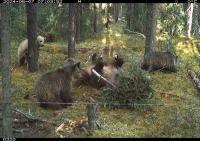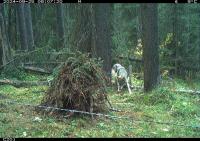
2024 Wildlife Highlights
Hair snag highlights from the 2024 season of the Grizzly Bear Monitoring Project
You can navigate by clicking on the map pins or an image below to start scrolling through the tour.
Site Setup
Site Setup. Click to expand.
In the middle of a barbed wire corral, we stack up a brush pile and pour one of several different scent lures that we're testing.
Non-invasive Monitoring
Non-invasive Monitoring. Click to expand.
Here you can get a really clear look at how effective this method is for getting DNA from bears without them even realizing they're giving us a sample. The DNA is in the hair follicle – the little bulb at the base of a hair.
Cougar and Her Kits
Cougar and Her Kits. Click to expand.
Juvenile cougars stay with their mother for one or two years. They leave when their mother is ready to breed again so they aren't killed by adult males.
Bear Family Party
Bear Family Party. Click to expand.
This is an example of where it is extremely useful to have a trail camera at each site so we can verify which barbs have hair tufts from different individuals. This lets us submit better samples to the lab for DNA analysis.

Hare Snags
Hare Snags. Click to expand.
Although trail cameras allow us to collect some very useful information, they also record a lot of images that we have to sift through. It takes a lot of time to classify and organize the photos and videos. To illustrate the volume, here's a time lapse from one site, where nothing showed up for a few months, except hares.
Comparing Coyote and Wolf
Comparing Coyote and Wolf. Click to expand.
You can get a good sense of the difference in size between a coyote and a wolf in this video. Wolf paw prints are about twice the size of a coyote's. Besides being shorter and leaner, the coyote has pointy, almost fox-like features vs. the wolf's more rounded face and ears.

Moose Family
Moose Family. Click to expand.
Moose are the largest member of the deer family in the world, and while most predators will avoid a healthy adult moose, their calves are a common spring food source for bears.
Rub Trees
Rub Trees. Click to expand.
Bears like to rub on trees. They might be leaving chemical messages for other bears or maybe just having a good scratch. Whatever the reason, we can use this behaviour to our advantage by putting some barbed wire and scent lure on trees to collect hair from animals that are wary of our normal lure sites.
Rub Trees Continued
Rub Trees Continued. Click to expand.
Here's a great example of a grizzly using a rub tree. What do you think – is it scent marking or scratching? Trying to shake a squirrel out of the tree top? It's possible we got a sample from this interaction, either from a barb down by its butt, or even a tuft of hair wedged in the bark.
Black Bear Gets the Message
Black Bear Gets the Message. Click to expand.
Did you guess back scratch or marking for the last one? Whatever the grizzly's intention, this black bear seems to be interested in finding out all about who was there 10 days earlier.

Wolverine
Wolverine. Click to expand.
It's rare to see wolverines, so it's no surprise that information on their populations in Alberta is sparse. But if you're lucky enough to spot them or their sign, you can help! Submit your observation to Wolverine Watch, a group filling in some of those data gaps.
The Lynx and the Hare
The Lynx and the Hare. Click to expand.
These two animals make up one of the classic predator-prey case studies in population ecology. A boom in the number of hares causes a boom in the number of lynx, which causes a drop in the hare population, which causes a crash in the lynx population, which causes a boom in the hare population...
Revisiting Sites
Revisiting Sites. Click to expand.
We try to return to each hair snag site every couple weeks for two reasons. First, we want to collect the hair while it's fresh and before it blows away or gets mixed up with the hair of another visiting bear. Second, bears like to absolutely obliterate the scent lure piles and we need to refresh them.
American Marten
American Marten. Click to expand.
This excellent little climber is at home in the mature pine forests of the foothills where it can find plenty of bird nests and rodents to feed on.
Fisher
Fisher. Click to expand.
The fisher is the larger, darker cousin of the marten, and although it can certainly climb trees, it seems to spend more time on the ground where it hunts. Like many in the weasel family, they take prey far larger than themselves. They eat squirrels and birds, but also trickier prey such as porcupines, foxes, even deer fawns and lynx.
Wild Horses
Wild Horses. Click to expand.
The Alberta Government estimates that there are well over 1,000 feral horses in the east slopes south of the Brazeau River.
Comparing Bear Sizes
Comparing Bear Sizes. Click to expand.
A grizzly and a black bear walk in at exactly the same spot at this site, giving us a really good comparison of their sizes. The barbed wire strand is about 50cm high, by the way.
Buck
Buck. Click to expand.
Antlers are pretty cool. Unlike a sheep's horn, which is made of keratin like a hoof or your finger nails, antlers are made of living bone tissue. Now we're wondering... does this count as an exoskeleton?
Wolf
Wolf. Click to expand.
Years ago, we had a project where we'd fly out to caribou mortalities to try to determine cause of death. The goal was to understand the threats to their populations. The field team could usually figure out what predator had been involved by looking at the carcass.

Red Squirrel
Red Squirrel. Click to expand.
Have you ever been bushwhacking in a conifer forest and come across a mushroom sitting on a bough at about chest height? Did it drop out of the sky? Is your hiking buddy leaving fungus-crumbs to help you find your way out?















